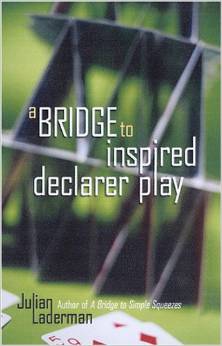 Source: A Bridge to Inspired Declarer Play by Julian Laderman
Source: A Bridge to Inspired Declarer Play by Julian Laderman
Dealer West O/E Vulnerable
| |
| |
| West | North | East | South |
| 1 |
|||
| Pass | 2 |
Pass | 3 |
| Pass | 4 |
The End |
West leads the ![]() A then shifts to the
A then shifts to the ![]() Q. How will you reduce four losers to three?
Q. How will you reduce four losers to three?
| |
||
| |
When a bridge player has to make an opening lead he is elated to find a suit in which he holds both the ace and the king. Leading either the ace or king of that suit is considered one of the most desirable leads. It will rarely hurt the defense. However, even though all bridge books endorse leading the suit, there are differing opinions as whether to lead the ace or the king.
The standard lead from this holding is still considered by some to be the king, but most modern bridge partnerships have switched over to leading the ace. The difficulty with leading the king from this holding is that the king would also be led if the opening leader holds both the king and the queen but not the ace. Therefore, in some cases when the king is led, the partner of the opening leader may not be able to tell which holding is held by the leader.
The difficulty with leading the ace is that there are occasions when the opening leader leads the ace even though he does not have the king. When this occurs, the partner of the opening leader may be misled as to who holds the king. A third alternative is for a partnership to have the understanding that the lead of an ace requires partner to respond with an attitude signal, while the king asks for count.
In this problem, the ace was led from the A-K combination. The deal is an example of a rare situation where this lead was unfortunate for the defense. Of course, whatever is unfortunate for the defense is fortunate for the declarer.
Declarer is looking at four losers: one club, one diamond and two hearts.
Suppose the defense shifts to a heart after winning the club ace. This will convert the heart slow losers into fast losers. Declarer can win the heart, play two rounds of spades ending in dummy and play the ![]() Q. Even though it is reasonably clear from the opening lead that West holds the
Q. Even though it is reasonably clear from the opening lead that West holds the ![]() K, declarer should not ruff but, instead, discard the
K, declarer should not ruff but, instead, discard the ![]() 3.
3.
Eventually declarer will get to dummy and play the ![]() J, discarding the
J, discarding the ![]() 2. He will not lose any diamonds, and the 4
2. He will not lose any diamonds, and the 4![]() contract will succeed.
contract will succeed.
When a losing card is played from both declarer and dummy in different suits (in this case dummy’s ![]() Q and declarer’s
Q and declarer’s ![]() 3) it is called a loser-on-loser play. On this trick a heart loser was converted into a club loser. No obvious gain.
3) it is called a loser-on-loser play. On this trick a heart loser was converted into a club loser. No obvious gain.
An indirect gain is obtained by promoting a club winner, the jack, on which to throw the diamond loser. If the opening leader had chosen to lead the ![]() Q instead of
Q instead of ![]() A, this loser-on-loser play would not have been possible since when declarer loses the first round of clubs the defense can immediately grab two heart tricks.
A, this loser-on-loser play would not have been possible since when declarer loses the first round of clubs the defense can immediately grab two heart tricks.
In principle, the actual lead is normally a desirable and safe lead so the defense should not be too frustrated that it turned out so badly. The defenders will probably be busy discussing how one of declarer’s losers disappeared.
Type of play: Loser-on-loser. Establish a winner in dummy.
Inspirational features:
1) Slow loser in the diamond suit. Play would achieve nothing if the loser were a fast loser.
2) The uneven length between declarer and dummy in the club suit.
3) The power of the touching honors in the club suit.
Lose trick or do not try to win a trick: Lose a club trick that need not be lost. This play trades a heart loser for a club loser. The advantage is that the other club honor is promoted to a winner.
It is important to observe that declarer must first discard a heart and then the diamond because reversing the order will not work.
Esta entrada también está disponible en: Spanish

